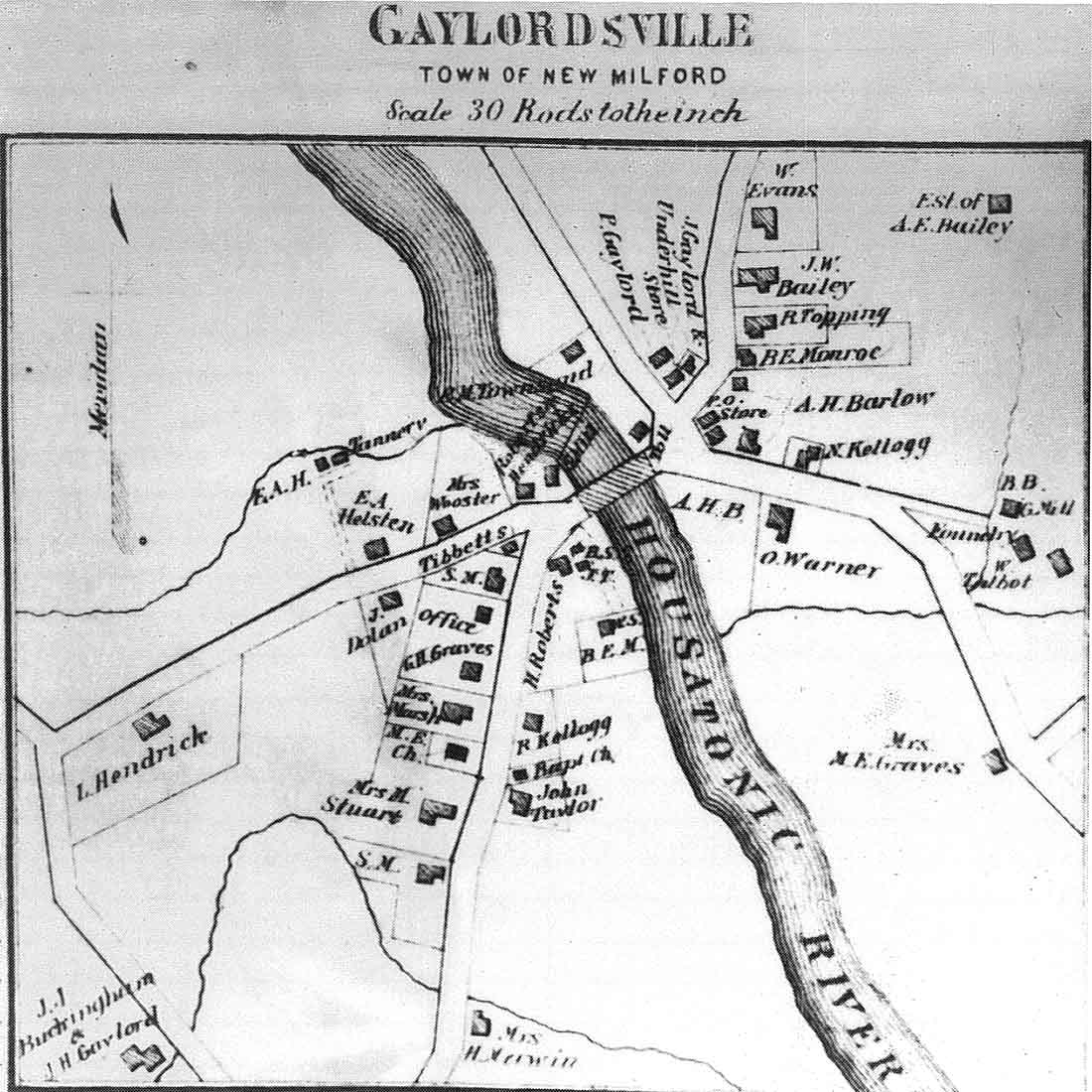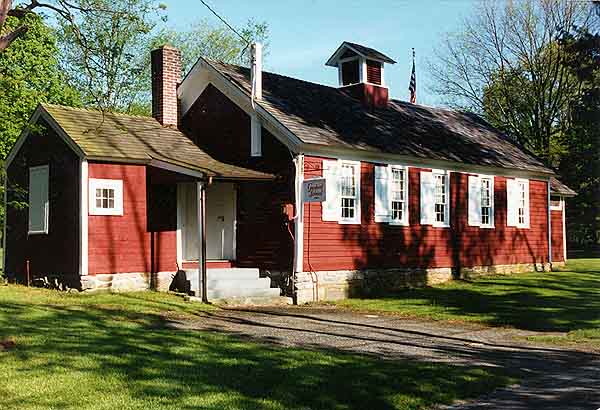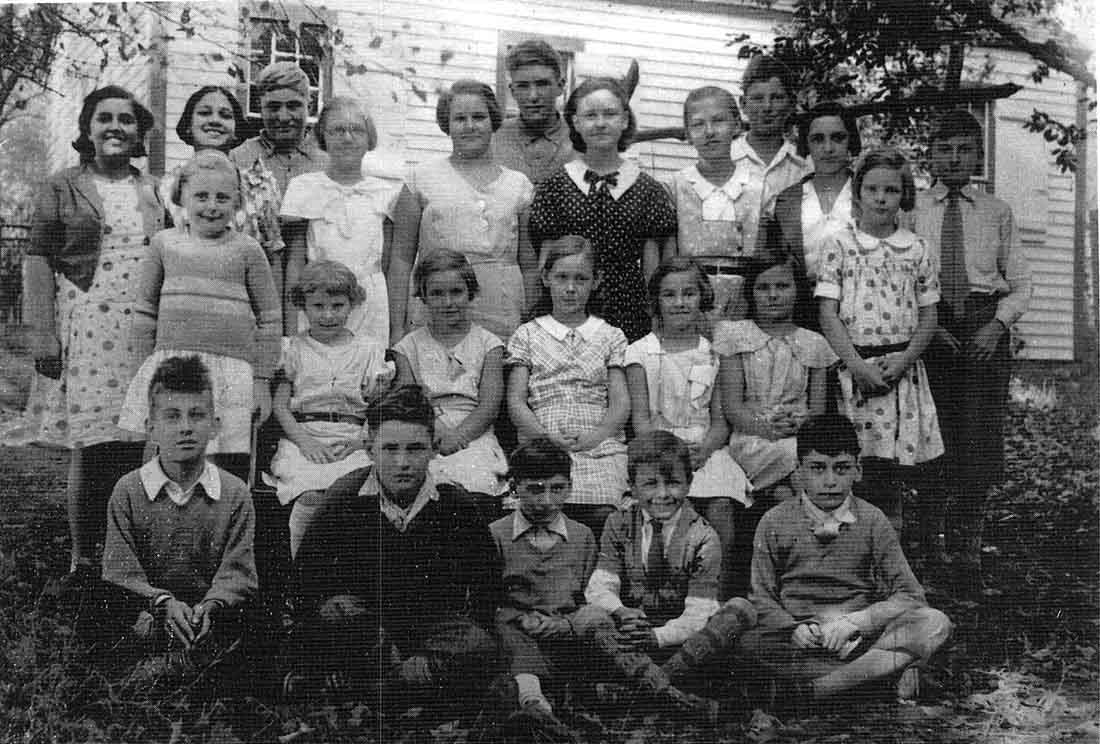Reminiscences of…
The Memoirs of Alan Dodd
Excerpts from the oral histories that Alan Dodd shared with the Historical Society in the late 1990s
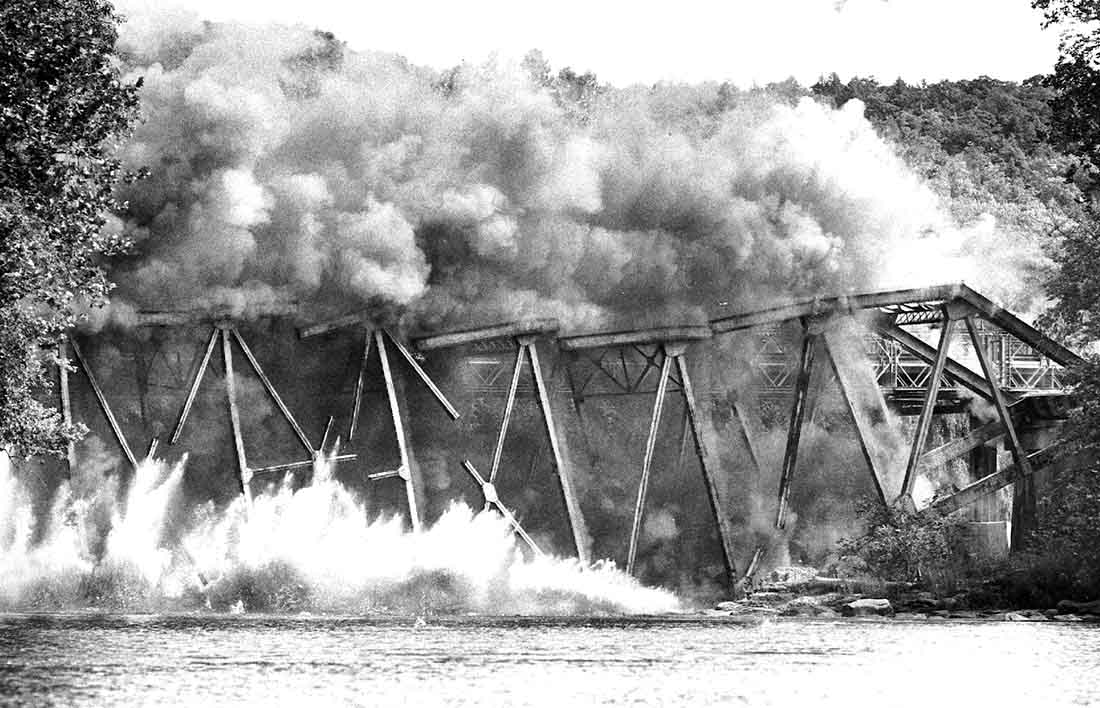
Rural Free Delivery at Gaylordsville
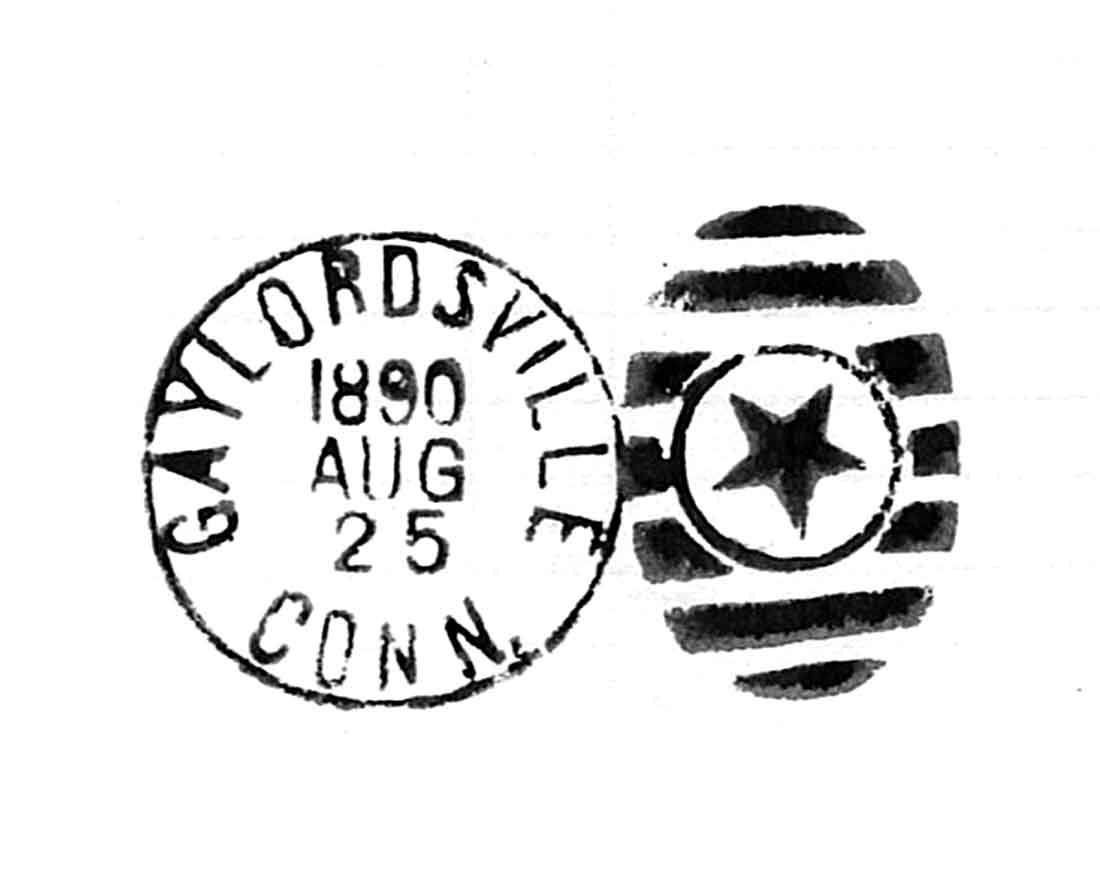 When I first came to Gaylordsville, Sherman had no post office and this mail came to the Gaylordsville Post Office and was delivered by RFD to Sherman residents. When I came to Gaylordsville, John Roche delivered the mail to Sherman. I was told that before him, Howard Conkrite delivered the mail on horseback. I don't know if he was the first or not.
When I first came to Gaylordsville, Sherman had no post office and this mail came to the Gaylordsville Post Office and was delivered by RFD to Sherman residents. When I came to Gaylordsville, John Roche delivered the mail to Sherman. I was told that before him, Howard Conkrite delivered the mail on horseback. I don't know if he was the first or not.
John delivered delivered the mail with horse and wagon or sleigh and later with a Model T Ford. He bought a new ModelT every year and kept the old one as a backup. In winter and spring he still had to use the wagon or sleigh on account of snow or mud.The wagon and sleigh both had a wooden body and roof and windows so John and the mail were out of the weather. John was the great uncle of Barbara Thorland who works at the Gaylordsville Post Office.
Several others had the job for short periods of time after John retired until John Flynn took the job just before Sherman got a post office. He was the last carrier to deliver Sherman mail from the Gaylordsville Post Office and the first to deliver it from the Sherman Post Office.
As the population of Gaylordsville grew,Gaylordsville got its own RFD route which operates from the Gaylordsville Post Office. I have read that this country and Canada are the only ones that have RFD service.
The Blizzard
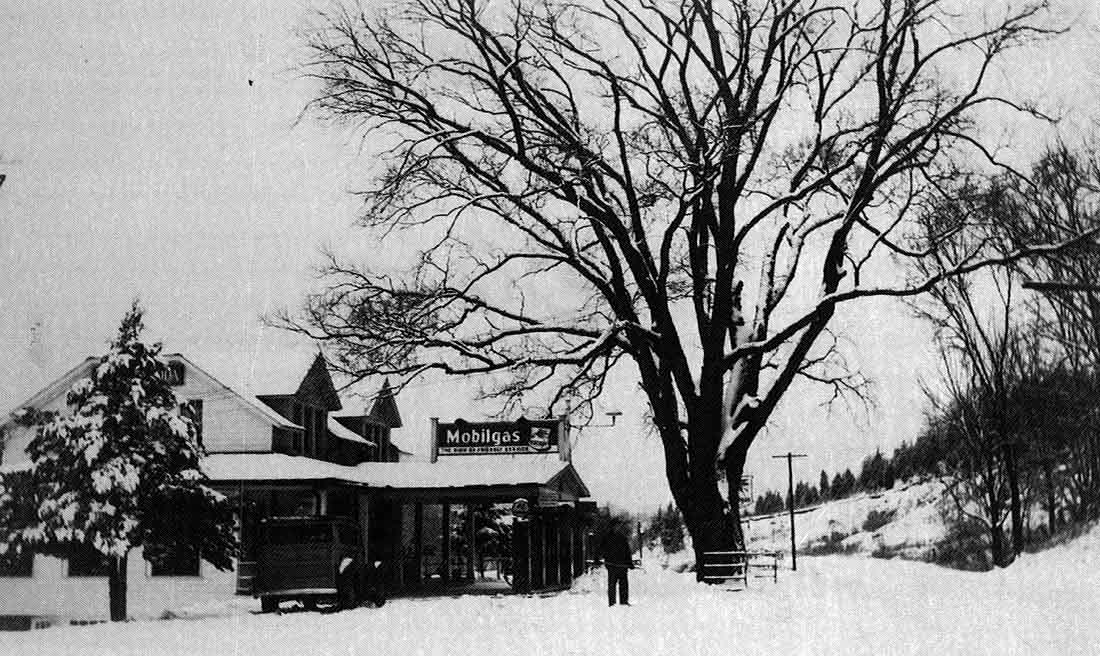 The worst snow storm I can remember happened about seventy years ago (1920). When we woke up that morning, it was snowing hard and looked like it had snowed all night. By afternoon the wind began to blow and the snow began to drift. Our house was in Gaylordsville,two miles south of the village and the road there was known to be the worst place for drifts between New Milford and Kent. By late afternoon the plows could not keep up and cars began to get stuck and have to shovel out.
The worst snow storm I can remember happened about seventy years ago (1920). When we woke up that morning, it was snowing hard and looked like it had snowed all night. By afternoon the wind began to blow and the snow began to drift. Our house was in Gaylordsville,two miles south of the village and the road there was known to be the worst place for drifts between New Milford and Kent. By late afternoon the plows could not keep up and cars began to get stuck and have to shovel out.
At that time there was bus service between Canaan and Danbury, southbound at 4 and northbound at 6:30. The southbound bus got stuck but managed to shovel out and the driver came to the house and telephoned Danbury not to send the northbound bus out as it could not get through. They didn't believe him.
Soon after that two women from Gaylordsville who knew us came to the door. They were stuck and scared and asked to stay all night. Mother, of course, told them they could. Soon after two more cars with a man in each car got stuck and they, too, came to the house.
At that time we had our own electric light plant so we were in no danger of losing power, and we kept bright lights on so people could see the house, as visibility was near zero. We had a wood-burning furnace and plenty of wood so everybody was warm.
Soon the driver and five male passengers from the northbound bus came in. The driver called Danbury and told them they were stuck but safe. They were still not smart and told him if he could not get through, they would send a driver that could. Soon we had three more added to our guest list. This made two women and eleven men and as there were six of us in our family, there was a full house. It was a big old farmhouse and mother had beds for the automobile people. The bus people slept in chairs and on the floor.
Mother got up the next morning and baked big pans of biscuits which she gave everybody for breakfast. A little later the plows got through and everybody got dug out.
Driving a Car in the Early 1920's
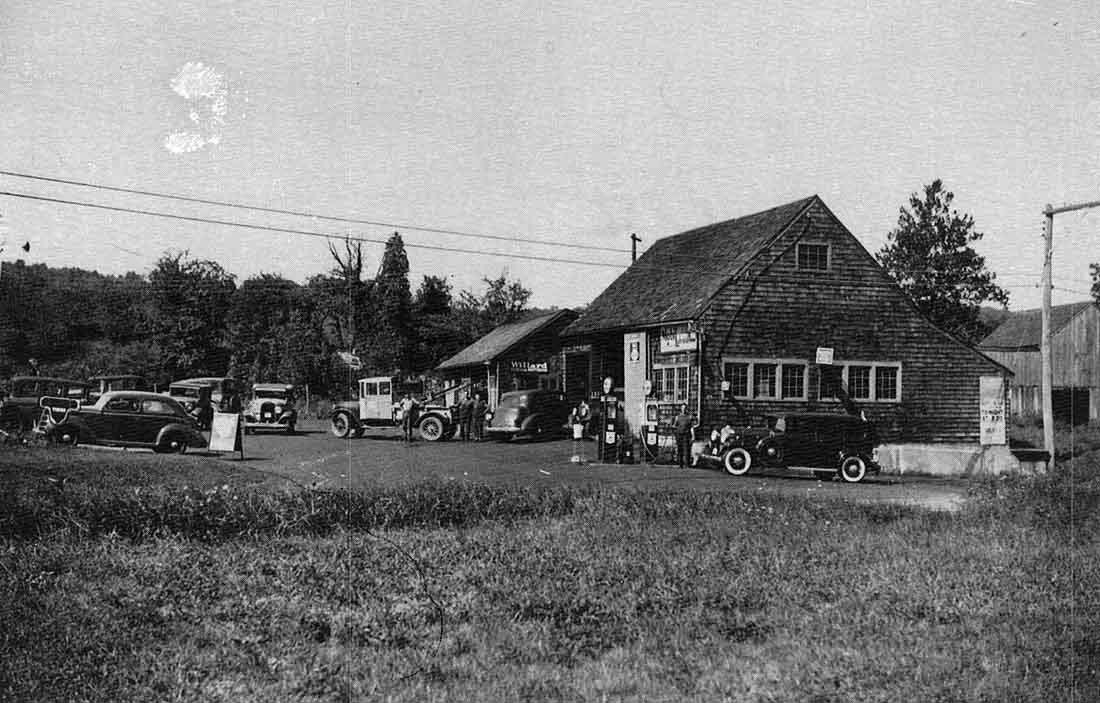 Before Route 7 was built in the early 20's we did not use cars in the winter as the snow was not plowed. Cars were stored for the winter and we used sleds drawn by horses.
Before Route 7 was built in the early 20's we did not use cars in the winter as the snow was not plowed. Cars were stored for the winter and we used sleds drawn by horses.
With the building of Route 7, the roads were plowed and we used cars all winter, but they used no salt. As sanding was done by a man with a shovel standing on the back of a truck, only the hills and corners were sanded. Side roads were not plowed and we had to use chains a lot. One of the big jobs for the garages was fixing tire chains. One of the sounds of winter was hearing broken cross chains clattering on the fenders of passing cars.
We had only one grade of oil...heavy...so we put a pint of kerosene in the crankcase and transmission so we could start and shift. Alcohol was our only antifreeze. As it evaporates before water, if you did not add antifreeze after a warm spell, you would freeze up the next cold spell. No heaters either.
The Milk Business in Gaylordsville
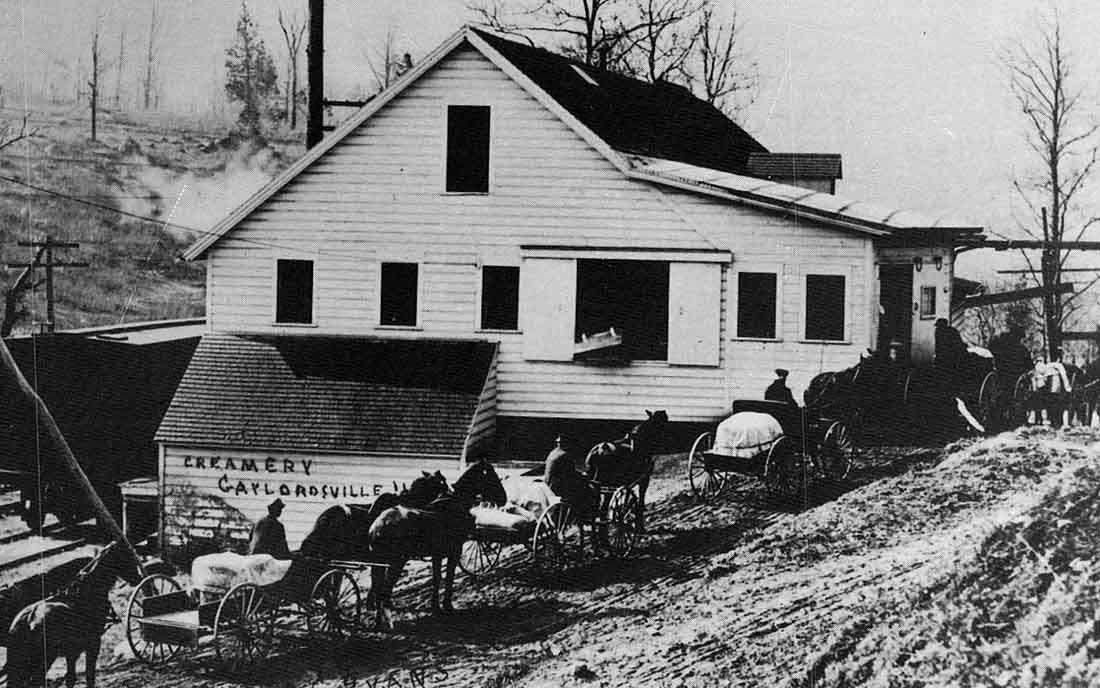 A few years ago dairy farming was the main industry in Gaylordsville. Now there are no farms left. Before the Creamery was built, most farms made butter and sold it. There was an engineer on the railroad who doubled as a butter salesman. Farmers would bring their butter to the station and he would take it on the locomotive to Danbury where he sold it.
A few years ago dairy farming was the main industry in Gaylordsville. Now there are no farms left. Before the Creamery was built, most farms made butter and sold it. There was an engineer on the railroad who doubled as a butter salesman. Farmers would bring their butter to the station and he would take it on the locomotive to Danbury where he sold it.
For a short time before the Creamery, the forty-quart cans of milk were put on a freight car and taken to the cities. The cans were taken from the cars in wagons and the milk delivered to the customers. The milk was dipped from the cans into the customers' pails. There were no sanitation laws.
At one time Sanford, one of the flynn sons, moved to Brooklyn, where he would take Flynn milk off off the train and sell it around the neighborhood. When the Creamery was built in 1890, the milk business boomed. Every farm, large or small, sold milk to the Creamery. The milk was delivered in 40-quart milk cans of the type that people now use for ornaments. Production would run from one can per farm to twelve for the bigger farms. Our farm sent five to six cans.
We were three miles from the Creamery and as a small boy I would often ride the milk wagon as an outing. At times there would be a line of wagons waiting their turn to unload. The milk was pasteurized and put in milk cans ready to ship. Every town along the railroad had a Creamery with a siding.
In the afternoon the "can" train came through, backed into the sidings and left carloads of empty cans. The next morning the "milk" train came through and picked up the full cans, taking milk to the city where it was bottled and delivered the next morning.
With the rather poor handling of time, milk had to be delivered every day as it would not keep long.
With today's modern cooling and handling, most milk is sold in stores and keeps a long time...a better product, but not as interesting as the old way.
Grandpa Dodd's Old Regal
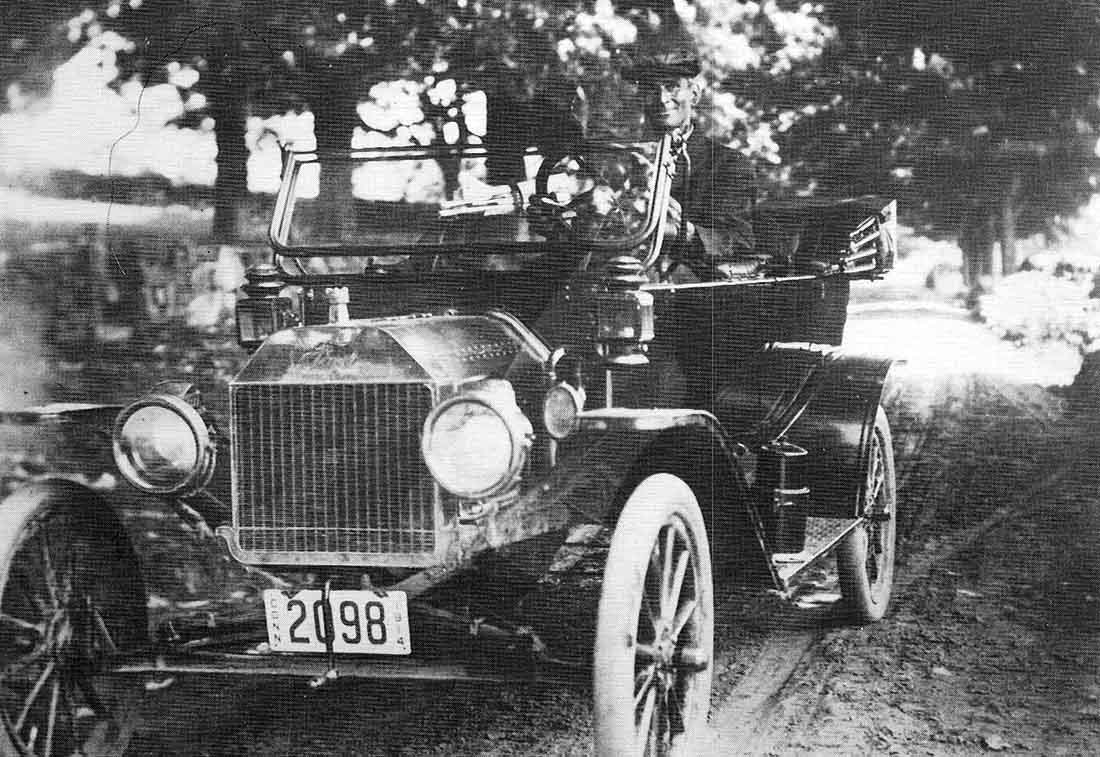 Grandpa Dodd had the first car in the Dodd and Flynn family - a 1912 Regal. It was a big four cylinder two speed touring car. I have been told I rode in it but do not remember. Grandpa's car had a top and a windshield, both were optional equipment. The car had gas headlights and kerosene taillights. The lights would go out and have to be re-lit with a match. When they ran out of matches, they would roll up paper and light one from the other. The kerosene taillights didn't go out. The car would stall going up hills and Grandma would have to find a rock to block the wheel while Grandpa cranked. On one trip she said it stalled so often, she carried a rock in her lap.
Grandpa Dodd had the first car in the Dodd and Flynn family - a 1912 Regal. It was a big four cylinder two speed touring car. I have been told I rode in it but do not remember. Grandpa's car had a top and a windshield, both were optional equipment. The car had gas headlights and kerosene taillights. The lights would go out and have to be re-lit with a match. When they ran out of matches, they would roll up paper and light one from the other. The kerosene taillights didn't go out. The car would stall going up hills and Grandma would have to find a rock to block the wheel while Grandpa cranked. On one trip she said it stalled so often, she carried a rock in her lap.
Mother used to tell many times of one trip when they had many troubles and the car got to running real well and blew my hat off. When I tried to holler, she clapped her hand over my mouth.Never mind the hat when the car was running good.
Building Route 7 in the Early 1920's
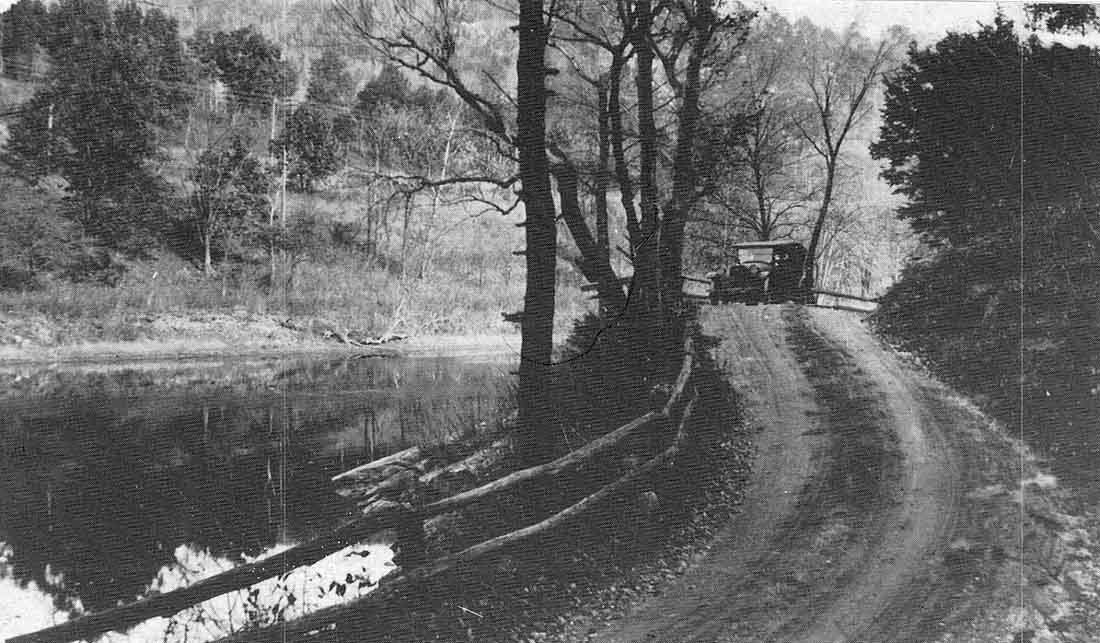 Before Route 7 was built, the mountain at Strait's Rock went down to the river with only room for a narrow road between mountain and river.The road then went into Cedar Hill Road, to Gaylord Road and to the village. This was the main road. Where the road is now was farm land. There was a big quarry at Strait's Rock with a large steam-powered stone crusher on each side of the corner.All the stone for the road between New Milford and Kent came from this quarry.
Before Route 7 was built, the mountain at Strait's Rock went down to the river with only room for a narrow road between mountain and river.The road then went into Cedar Hill Road, to Gaylord Road and to the village. This was the main road. Where the road is now was farm land. There was a big quarry at Strait's Rock with a large steam-powered stone crusher on each side of the corner.All the stone for the road between New Milford and Kent came from this quarry.
The trucks at that time had solid rubber tires and could only be used on a good road so all of the hauling on the job was done with many teams of horses and dump wagons. There were no bulldozers or pay loaders at that time so it took many men with shovels to spread and level the stone and dirt.
A small village of tar-paper covered buildings was on the lot north of what is now the Charlie DeCosa home. There was a dorm for the men to sleep in and a row of fireplaces for cooking and a store where they bought their food. They used a lot of canned goods. We plowed up tin cans for years after the land was again used for farming.
There was also a storage building, a blacksmith shop and a building over the boiler which supplied steam for the steam engine that ran the crusher and the steam drills for drilling holes for the blasting. There were no air drills as yet. The steam engines were big and heavy and could not be used everywhere, so some drilling was done by hand. One man held the drill and two men pounded it with sledge hammers.
My brother and I had to walk through the job everyday going to school, so we got a better view of it than anyone else.All machines, shovels, rollers and cranes, etc..., were powered by steam engines which burned soft coal. There were no diesels yet.
The Gaylordsville station was a busy place. All coal,cement and machinery came on the train and then were hauled to the job, using heavy wagons and horses.
A lot of the skilled labor came from New Milford and as it was better traveling on the east side of the river, a suspension bridge with cables fastened to trees was built for the men to walk over to the job.
As all the steam engines used a lot of water, a dam was built in Squash Hollow and a three-inch iron pipe was laid for half a mile to the quarry. Water for shovels, cranes and so forth was carried to them by water wagons drawn by horses.
As the bridge between the village and Strait's Rock was on new ground, a narrow gauge railroad was built to carry stone and supplies for building the bridge. My brother and I swiped apples and gave them to the engineer, hoping for a ride. They took our apples, but no ride.
Their machines were crude by today's standards. They spent a long time and did a lot of hard work by hand and with horses,but they did a good job. The road is still there after three quarters of a century of use and still carries a lot of traffic.
Great Grandfather John Flynn
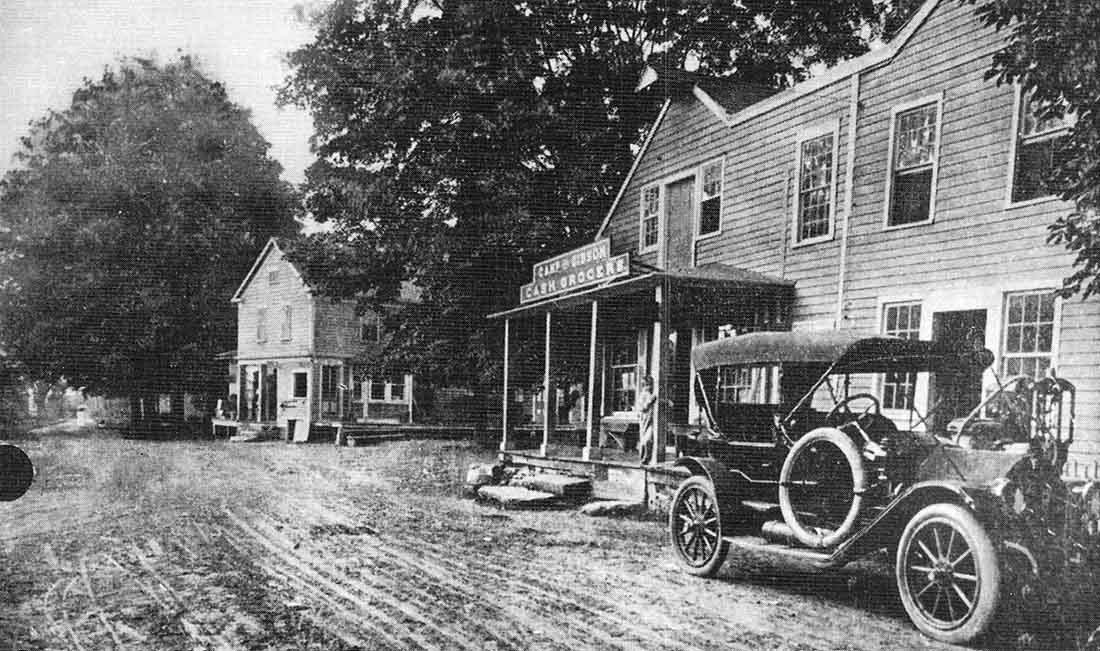 The first story I heard of grandpa Flynn was that he came to Canada from Ireland in the early 1800's. As the distance from Ireland to Montreal is much shorter and the fare is cheaper, a lot of Irish came over this way. They would stay in Canada until they got enough money to come to New York. They were called two-boat Irish by some of their countrymen and were not considered high class.
The first story I heard of grandpa Flynn was that he came to Canada from Ireland in the early 1800's. As the distance from Ireland to Montreal is much shorter and the fare is cheaper, a lot of Irish came over this way. They would stay in Canada until they got enough money to come to New York. They were called two-boat Irish by some of their countrymen and were not considered high class.
While in Canada, he met and married Jane Duncan, a Scotch woman, and some of their older children may have been born there. He came to New York and lived there for awhile and while visiting his cousins, the Dodds in Squash Hollow in New Milford,found that the next farm was for sale, bough it and moved there with his family. In a few years he bought another farm at the southern entrance to Squash Hollow and bordering on the Housatonic River.When Grandfather Dodd died, he bought his farm and used three farms.
He was a hard worker and a progressive farmer. He had the first silo in New Milford and the first horse-drawn corn harvester. He had the only steam powered mill in town. He had mills for grinding corn and sawing lumber, which he used to make ties for the railroad as well as other lumber. The engine was also used to run a threshing machine, shingle saw and for sawing stove wood, chopping corn and many other farm jobs.
When he was in his late middle age, I don't know his exact age, while bringing home some young stock that had pastured on Long Mountain, one would not cross the covered bridge. He got a rope and tried to lead her but she dragged him and broke his hip. The medicine at that time being what it was, he never was able to work again. My memory of him is as an old man with a white beard who walked with two canes.
When he was an old man, he sold the farm to his son,John II and bought a farm and orange grove in Winter Garden, Florida,where he lived until he died. He is buried in the Gaylord Cemetery.
He has a great grandson named John Flynn, so the name still goes on.
He had eight children, one died as a child. They were Thomas, James, Ann, Sanford, Margaret, John, Jenny and James. The first James died as a child and they must have named the last one after him.
The Old LaFrance
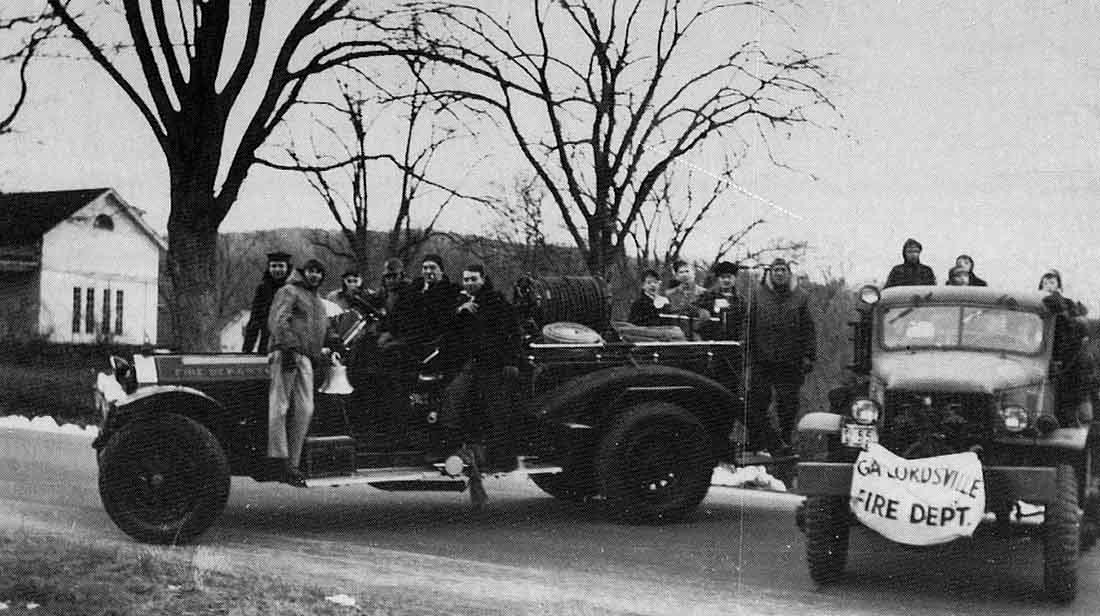 This was the first fire engine owned by the Gaylordsville Fire Department. We got it through the kindness of Chief Lou Mass of the Bay Shore Fire Department when his department retired it. We got them to let us have it for $240.00. This truck was about 25 years old when we got it. It was right hand drive with the gear shift and brake lever on the outside, with chain drive. Lou told me when they got the truck, it had solid rubber tires and what was then called a chemical tank, a hundred gallons of water activated by soda and acid like a soda-acid fire extinguisher. It was later equipped with a 250-gallon tank connected to the pump. The wheels were changed to take pneumatic tires.
This was the first fire engine owned by the Gaylordsville Fire Department. We got it through the kindness of Chief Lou Mass of the Bay Shore Fire Department when his department retired it. We got them to let us have it for $240.00. This truck was about 25 years old when we got it. It was right hand drive with the gear shift and brake lever on the outside, with chain drive. Lou told me when they got the truck, it had solid rubber tires and what was then called a chemical tank, a hundred gallons of water activated by soda and acid like a soda-acid fire extinguisher. It was later equipped with a 250-gallon tank connected to the pump. The wheels were changed to take pneumatic tires.
It had no cab or windshield and it was a cold ride in zero degree weather. We had helmets with face masks and goggles which helped, but not much.
It gave us good service for 20 years until we could afford a new truck. We wished we could keep it, but had no room to store it so we sold it to Robertson Bleachery, where they used it for a plant truck until they went out of business. I don't know where it went after that.Before we sold it, we took off the bell and hung it on the wall in the fire house meeting room where it still hangs.
New York, New Haven, and Hartford Railroad
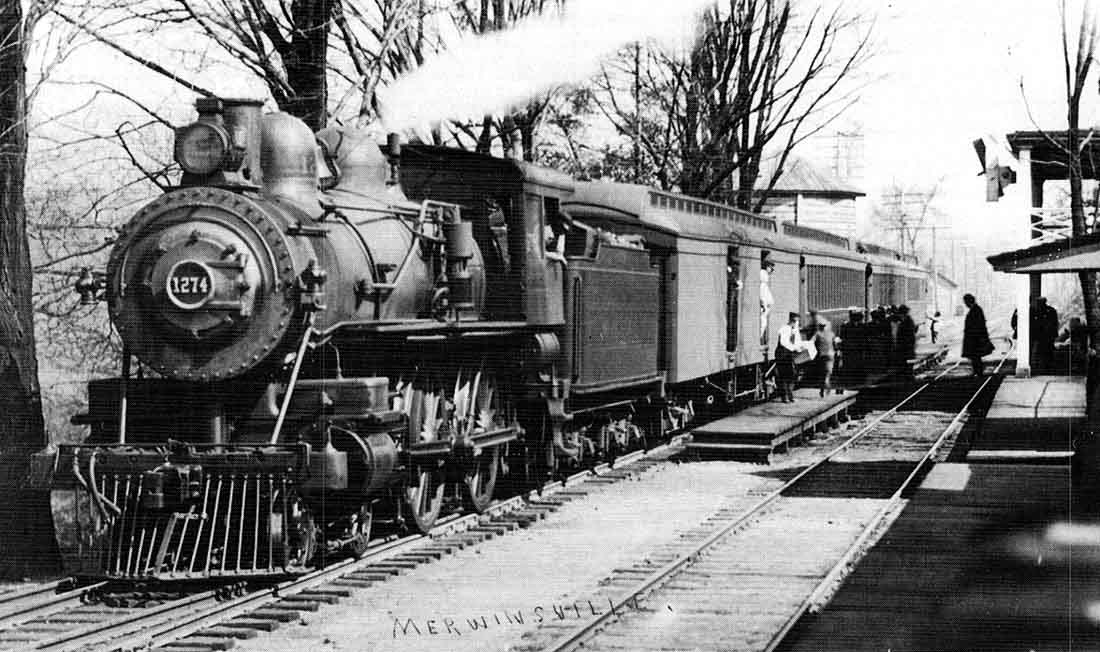 The New York, New Haven and Hartford in the teens was a large and busy railroad, much larger than the Housatonic before or the New Haven after. The line I am familiar with was the line between New York and Pittsfield. The station was a busy place. It was located between the crossing and the old hotel and was a combination freight and passenger station. There were two passenger trains each way every day. These trains carried a mail car and parlor car and the mail was sorted on the train and left off on the stops along the way.
The New York, New Haven and Hartford in the teens was a large and busy railroad, much larger than the Housatonic before or the New Haven after. The line I am familiar with was the line between New York and Pittsfield. The station was a busy place. It was located between the crossing and the old hotel and was a combination freight and passenger station. There were two passenger trains each way every day. These trains carried a mail car and parlor car and the mail was sorted on the train and left off on the stops along the way.
When the Derby Dam was built for water power in Derby factories, a man in Gaylordsville measured the height of the water,wrote it on a postcard and mailed it to Derby every morning. As the river takes a day or go from Gaylordsville to Derby, they knew how much water they had for the day. You couldn't do that today.
Gaylordsville was smaller then and there was no junk mail, so the mail went in one small bag and was taken to the station four times a day by horse and wagon. The milk train came down every morning, stopping by the Creamery sidings along the way for cars loaded with cans of milk, taking them to the city. In the afternoon the train came up through and left car loads of empty cans to be filled for the next day. Both trains carried a passenger car and were used as locals.
As there were few automobiles and most people could not afford to keep horses, the train was widely used for long and short trips. The high school students went to New Milford by train.
The track was kept in excellent condition by crews called section gangs, because each crew had a section of track to care for...one crew in Kent, one in Gaylordsville, one in New Milford, etc... A man walked and inspected every mile of track everyday. Mike Hastings, grandfather of Ginny Smith, was head of the Gaylordsville gang for many years. He owned and lived in the Merwinsville Hotel. One time when Mike had a little too much cider,he rode his donkey into the station full of passengers, causing quite a stir, especially when the donkey proved he wasn't housebroken.
Ezra Atkins, father of george Atkins, was Station Agent for most of the time I remember. The freight business was large and there were few trucks and everything from horse shoes for the blacksmith to groceries for the store came by freight.
There was a siding for leaving car loads of coal,feed, lumber, and sometimes a carload of horse manure from a livery stable in the city to be used for tobacco fertilizer.
For some reason known only to the railroad, the Gaylordsville station was known as Merwinsville for many years, which was very confusing to passengers wishing to buy a ticket to Gaylordsville.
Near the Front Of The Mountain Road was a cattle loading pen. As there were no trucks, cattle were driven there to be loaded on the train and shipped to the city for beef. Gaylordsville never had a crossing gate, only bells and a sign that said "RAILROAD STOP, LOOK AND LISTEN". Later flashing lights were installed.
In the early days of the New York, New Haven and Hartford, there was a large trolley system in northwestern Connecticut, Massachusetts and Vermont, connecting with trains not on the railroad. You could go from Caanan, Connecticut to Bennington,Vermont by trolley.
When Theodore Roosevelt was running for his second term as President, he left his train in Great Barrington and went by automobile to make a speech in another town. The car was hit by a trolley and a Secret Service man killed. The President was shaken but unhurt and later that day made a speech in New Milford. The speech was heard by my uncle, Harry Dodd.
There was only one bad wreck that I remember. Somewhere north of Gaylordsville a locomotive turned over, killing the engineer, fireman and brakeman. The brakeman was Charlie Struab,a former resident of Gaylordsville.
The New York, New Haven and Hartford became the New Haven and a branch of the Pennsylvania, getting smaller all the time and disappearing entirely for many years.
In late years the road has been restored by the Housatonic Railroad, who haul car load lots between Danbury and Pittsfield. It is good to see and hear trains in Gaylordsville again,but not much like the old days.
I Remember Bank Street
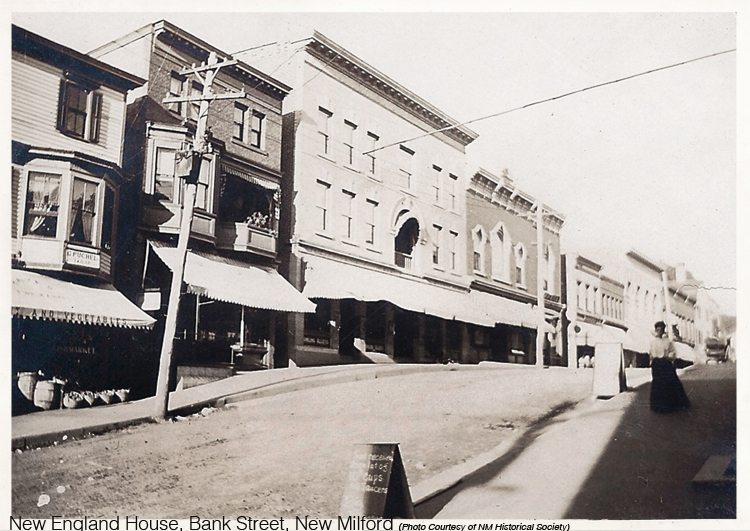 With all the talk about Bank Street, I think about what it was like in the '20's when I went to high school. New Milford was the main shopping area for everybody between Kent and Brookfield,including Sherman, Roxbury and Bridgewater. Most of the stores were on Bank Street. There were three drug stores, two jewelry stores, a grocery store, theater, a 5&10 cent store, furniture store, three ice cream stores, a stationery store that also sold toys, sporting goods and radios.
With all the talk about Bank Street, I think about what it was like in the '20's when I went to high school. New Milford was the main shopping area for everybody between Kent and Brookfield,including Sherman, Roxbury and Bridgewater. Most of the stores were on Bank Street. There were three drug stores, two jewelry stores, a grocery store, theater, a 5&10 cent store, furniture store, three ice cream stores, a stationery store that also sold toys, sporting goods and radios.
There were five clothing stores on the street. Most sold both men's and women's clothing, but one, Duncan and Canfield,sold only men's and boys' clothes. Both men smoked cigars all day and everything in the store smelled like cigars. When my brother and I were little, we thought new suits were supposed to smell like that.
New Milford had two banks at the corner of Bank and Main Streets, the New Milford Savings Bank and The First National Bank of New Milford. The space between Bank and Church Streets was called the hitching rail and had a row of chestnut rails on each side where people could hitch their horses when they were shopping on Bank Street. The horses were gone in my time the rails were still there.
Saturday night was a big time on Bank Street.Everybody for miles around came to town to do their shopping, get hair cuts, and visits with their neighbors. The Salvation Army was always there Saturday nights with a band at the foot of Bank Street and women went through the stores, barber shops and the theater lobby collecting money for the poor in their tambourines.
The theater always had a special Saturday show.Besides the feature movie you got a comedy, a newsreel and one installment of a serial. This always left the leading lady in a bad fix, easily solved the next week. The recent closing of Carrier's store marks the closing of last of the old Bank Street stores. It was in the family for three generations and is the end of an era. Goldens was the last of the big department stores on the street and Bartons moved to Main Street. New Milford lost something with the end of the end of the Bank Street era. Merchants and customers knew each other then and were friends, different from today's supermarkets and malls.
The Gaylord School In The Teens
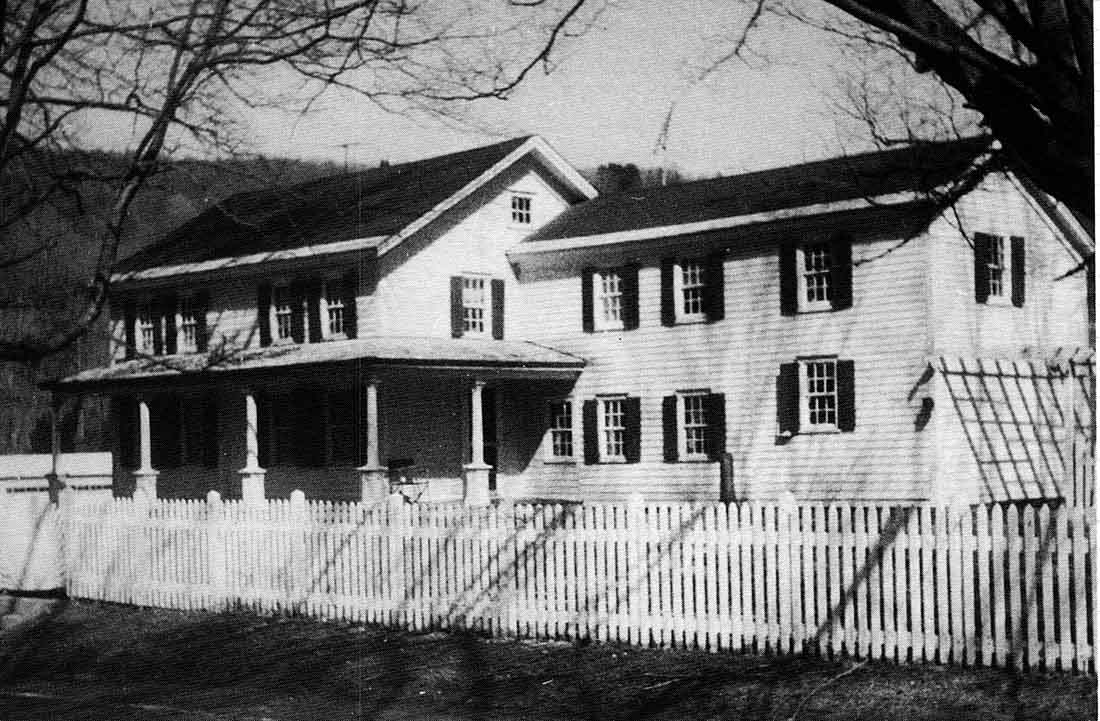 I was seven when I first went to the Gaylord School. We lived on a farm where Strait's Rock Estates is now, on a dirt road with only one house in the mile between our house and the school. My mother kept me back until my brother was old enough to go with me.
I was seven when I first went to the Gaylord School. We lived on a farm where Strait's Rock Estates is now, on a dirt road with only one house in the mile between our house and the school. My mother kept me back until my brother was old enough to go with me.
The school had eight grades with from two to four pupils in each grade. Our first grade had four boys; Alan Dodd, Jack Dodd, Jimmy Dolan and Roy Fredlund. Bessie Cornwell was the teacher and she was still teaching when my own children went to school. People who never went to a one-room school might think there was confusion with eight grades in one room. Actually there was none. Each class went to the front of the room to recite their lessons,while the rest stayed in their seats. There was never a problem with so many different ages on the playground, which mostly was the road in front of the school. It was a dirt road with little traffic and what traffic there was knew enough to watch out for school children. The present playground in back of the school came about ten years later and has an interesting history. A wealthy man bought the farm south of the school; a Mr. Silver, and he objected to the view of the toilets between his house and the school. He offered to give the land for a playground if the toilets were moved. they were moved and the school got a good playground. By that time there was more traffic on Gaylord Road and the school needed the extra space. The playground was a corn lot when I went there to school.
The schoolhouse had stone steps to an entryway, one side was a door for the boys and the other side a door for the girls. Inside were shelves for dinner pails and hooks for hats and coats. There was also a bench for the water pail. Water was carried from a neighbor's house. It was a privilege for two children to go for water during school hours.
Most children walked a mile to school, and a few walked a mile and a half. It was not hard in warm weather but hard in the winter as it was cold and the road was not plowed. We walked in the tracks made by horses and sleds.
The school was heated with a wood stove and on cold mornings, we sat as close to the stove as we could get until the room warmed up.
There was no playground equipment. We brought our own gloves and bats and played baseball in the road. Many brought their sleds in the winter.
In summer the boys ate lunch at recess time and dashed down to a swimming hole opposite the Gaylord Cemetery. Men or boys did not own bathing suits. I don't know what the girls wore, as there was no mixed bathing.
There was no dress code but everybody was neat. The girls wore dresses, of course, as there was no jeans yet. Some boys wore bib overalls and in warm weather, most boys and some girls went barefoot.
There were few behavior problems. Discipline was good at school and at home. We enjoyed life and got a good education. I am glad I went to a one-room school.
New Milford High School In The Teens And Twenties
The high school was on Main Street in New Milford in the building now known as the Paul Richmond Senior Center. The town furnished the building, hired the teachers and bought the books, but supplied no busses.
If you were lucky enough, as Gaylordsville people were, to live where there was public transportation, you could ride on the train. The train came through at six o'clock. You bought your own ticket and some walked a mile to get to the station.
Many students walked to school. Some rode horses or bicycles and some boarded in the village. You couldn't get a driver's license at that time until you were eighteen, so few could use a car.
There was a Classical Course for those going to college and a General Course for those who did not expect to go further. Everybody took English, Math, and History, and there were choices of several things, such as Agriculture, Home Economics, Typing, Bookkeeping and Music.
Discipline was simple. If you didn't want to be punished, you behaved. If you didn't, you were punished. Mr. John Pettibone was strict but always fair.
The only weapon I remember being brought to school was a pair of brass knuckles brought by a boy who used them on someone. He was taken to the office and paddled and told by Mr. Pettibone that if he wanted to fight, he (Mr. Pettibone) would fight with him. No more weapons.
The only sports were baseball and basketball for boys, and basketball for girls. There wasn’t room enough at school for a baseball field so the team played at Young's Field where the town team had a diamond which they let the school use.
The school auditorium was not big enough for basketball, so games were played in the upper story of the Town Hall in the space later used as a courtroom. Other school activities such as a Senior Play, Junior Prom, and graduation were also held there.
Life was simple then. We did not feel underprivileged. We had no dress code but everybody was neat. Nobody got to high school that couldn't read and add and no one graduated without an education. It was easier because we were a small class. My class of 1929 had 46 members.
I Remember Clarence Evans
 When I first knew Clarence, he seemed an old man to me, though he really was not. He was very bald, homely, with a big nose and an odd way of speaking. He did not give the impression of being the smart man that he really was.
When I first knew Clarence, he seemed an old man to me, though he really was not. He was very bald, homely, with a big nose and an odd way of speaking. He did not give the impression of being the smart man that he really was.
He still took pictures of everything that happened in Gaylordsville, but no longer sold any, as by my time everyone had their own cameras.
When he was young, he bought a big glass plate camera and went to a school to learn to take pictures and develop and print plates. He went to picnics, parades, ball games, etc. as well as did portrait and family pictures and sold the prints. He probably had the only camera in town at one time.
He was a photographer of the old school. He learned to take pictures when they were hard to take and never changed, even when he had a modern camera and modern film. He spent a long time and took one GOOD picture, instead of taking a lot and using the best as people do now.
In the quality and composition of his pictures he was a genius. His fault was that he never labeled any of his plates. He left many dozens and even though many have been made into prints and slides, no one is old enough to identify many of them. Many of the pictures shown at the Gaylord School and many in John Flynn's "History of Gaylordsville" are from his pictures.
The Gaylordsville Historical Society has a diary written by Clarence as a young man, when he and his father ran a farm between South Kent Road and the river. They sold eggs, milk and tobacco. Their farm was located between the two roads and the barn has since burned down.
Clarence sold building lots to George Ward for the Basket Shop and to Thomas Honan for the store and post office. He donated the lot to the Gaylordsville Fire Department for their firehouse. He kept a piece between the store and the firehouse so he could walk to the store on his own land.
Clarence was a good citizen of Gaylordsville, active in the church and Grange. When he was well past middle age, he met and married a retired school teacher from the city who was spending the summer in Gaylordsville. Though they were extreme opposites, they seemed to have been happy together for a long time.
Clarence’s main job for many years was carrying the mail between the post office and the railroad station, first with a horse and wagon, and then with a Model T Ford and at last a Model A. There were four mails a day at 9, 11, 4 and 6 so in the days of the horse and wagon, it took most of his day. It was a contract job and I have been told that knowing that no one else wanted the job, once in awhile Clarence would quit and bid it in for more money and get a raise.
Clarence lived to be in his eighties and died in the middle of a cold, snowy winter. I was one of his pall bearers. His funeral was at the church and as there was deep snow and cold, only the pall bearers went to the Gaylord Cemetery. So ended my acquaintance with Clarence Evans.
John D. Flynn
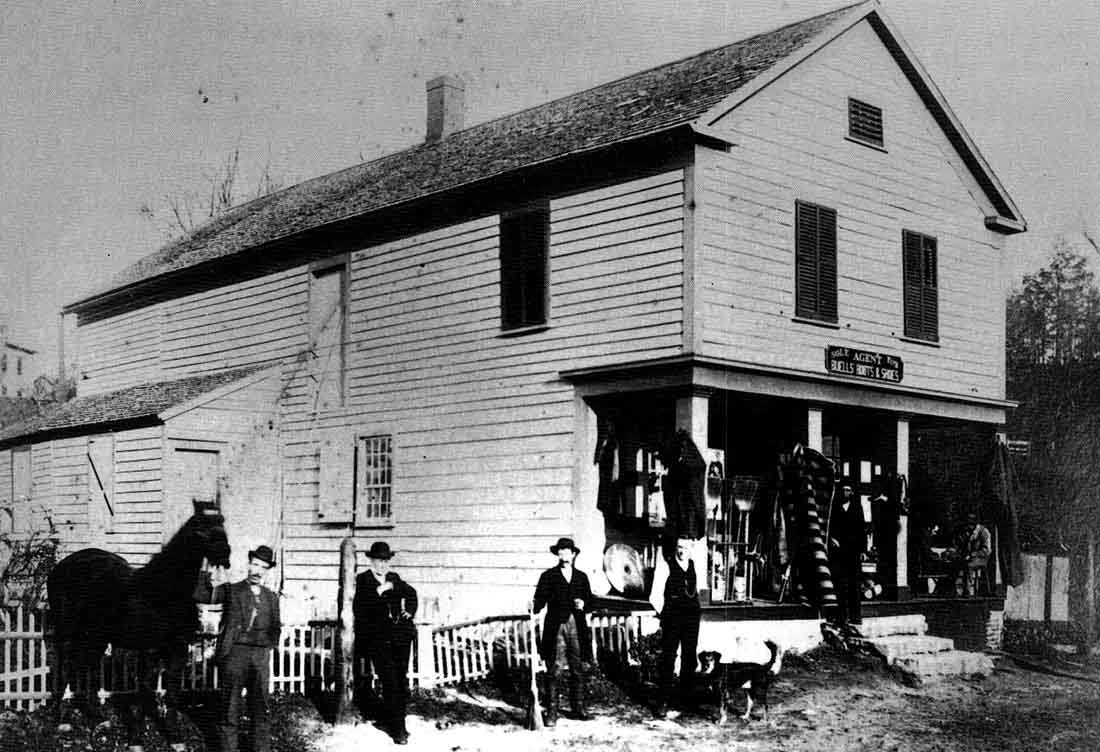 John D. Flynn was the founder and first President of the Gaylordsville Historical Society. New members will not remember John. He was born on August 20, 1921, in the first New Milford Hospital, which was on Whittlesey Avenue. The building was torn down when the New Milford Library addition was built.
John D. Flynn was the founder and first President of the Gaylordsville Historical Society. New members will not remember John. He was born on August 20, 1921, in the first New Milford Hospital, which was on Whittlesey Avenue. The building was torn down when the New Milford Library addition was built.
John went to school at the Gaylord one-room school and to New Milford High School and Abbott Tech trade school in Danbury. When he graduated from trade school, World War II was starting and he joined the Army Air Force.
After the war he worked on our farm and for the state highway for a few years, and then got the job of RFD mail carrier for the town of Sherman. Sherman at the time had no post office and their mail came to the Gaylordsville Post Office and was delivered RFD to the homes in Sherman. When Sherman got their post office, he became the first RFD carrier from that office.
He was always interested in Gaylordsville history and spent a lot of time over the years collecting items and pictures. He wrote a book "The History of Gaylordsville," now in its third printing. Most of the pictures at the Gaylord School are ones he collected.
He had the idea of a Gaylordsville Historical Society and became its first President. He started the practice of the Gaylordsville Historical Society caring for Brown's Forge.
The Bridges of Gaylordsville
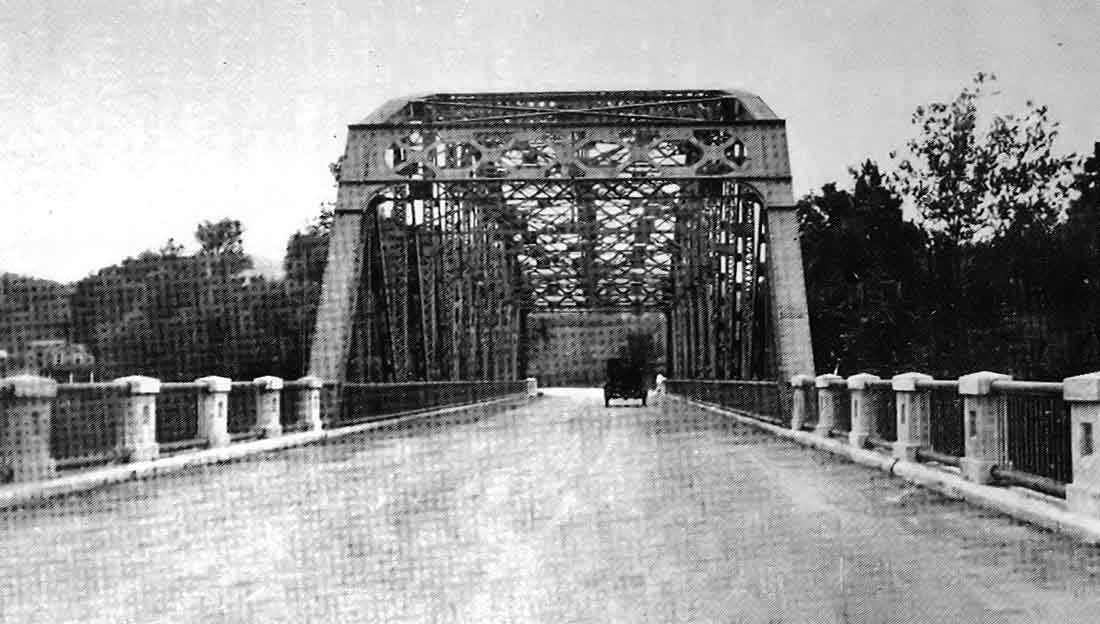 The first mention of a bridge in Gaylordsville was in 1803 and was used until 1845. The money for the bridge was raised by selling stock and this was a toll bridge. It was washed out in a spring flood. A higher covered bridge was built about 1855 and was used until 1875 when an early high spring flood took it away.
The first mention of a bridge in Gaylordsville was in 1803 and was used until 1845. The money for the bridge was raised by selling stock and this was a toll bridge. It was washed out in a spring flood. A higher covered bridge was built about 1855 and was used until 1875 when an early high spring flood took it away.
A higher pier and a new covered bridge lasted until the bridge was taken down when Route 7 was completed and it was replaced with a steel bridge. This was replaced in recent years with a modern cement bridge.
I wish we still had the old covered bridge, but it probably would have gone in the 1955 flood. The water was over the center pier of the old bridge which was standing at the time.
The stone posts at the entrance to Morningside Cemetery are stones from the center pier of the old covered bridge.
It is hard today to realize how important bridges were to people of that time. Towns were named for them, such as Cornwall Bridge. This bridge was lost during the hurricane of 1938.
During the 1800's a man in Pennsylvania thought that by putting a roof on a bridge and protecting the timber from the weather, the bridge would last forever. Because of his idea, we still have covered bridges. They are thought of as being typically New England. We have many, but I have crossed them in the south and in Canada.
We have only two left in Connecticut...Bulls Bridge and the West Cornwall bridge. They have been reinforced by the state to bear today's heavy traffic and should last forever.
The History of the World War II Memorial & the Charlie Jones Park
Charlie Jones lived his entire life in Gaylordsville. He went to the one-room Gaylord School and New Milford High School. Most of his career was spent with the State Highway Department and at the end was in charge of several crews in the area.
He was an active member of the Gaylordsville Methodist Church and a charter member, first captain and ex-chief of the fire department.
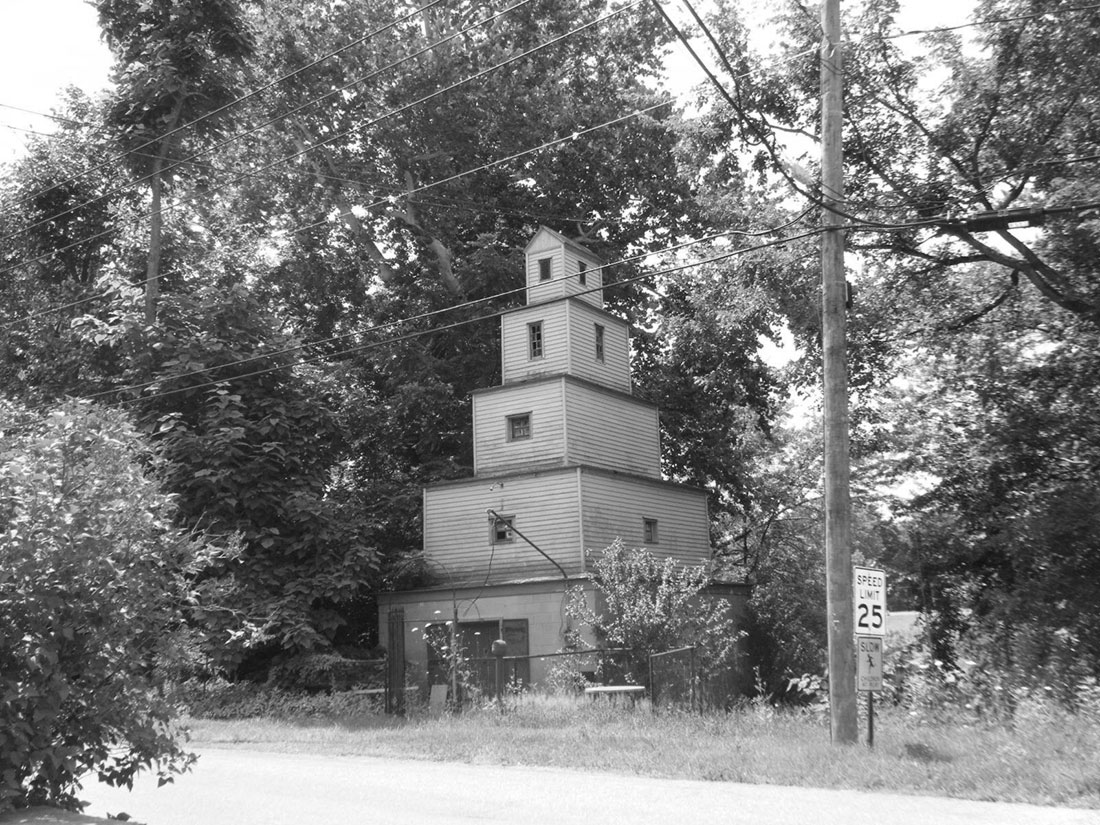 After WW II when the Memorial Stone with the names of Gaylordsville servicemen was placed he then took charge of Gaylordsville’s first Memorial Day service, which he continued to do for many years as long as he was able.
After WW II when the Memorial Stone with the names of Gaylordsville servicemen was placed he then took charge of Gaylordsville’s first Memorial Day service, which he continued to do for many years as long as he was able.
During World War II women in Gaylordsville, headed by Nora Hastings, formed the Gaylordsville Knitting Club. The women got patterns from the Red Cross, bought yarn and made socks, sweaters and other knitted items for the soldiers. They raised money to buy yarn, and at the end of the war, had money left in their treasury.
Mrs. Hastings had the idea of a monument for the men and women in Gaylordsville who served in WW II. A suitable stone was found in Squash Hollow. Art Sega furnished a crane and tracks to move the stone on. It was placed on a small park that at the time was between the north and south entrances from Route 7 to Route 55.
As the Knitting Club had discontinued, Mrs. Hastings asked the Fire Department to take charge of a suitable service there every Memorial Day. When the state changed the entrance to Route 55, the park was removed and the stone was temporarily placed on the north end of the Firemens' Field and was later moved to its present location across from the post office.
Charlie Jones took charge of the Memorial Day services from the first one, and continued to do so for many years until he was no longer able. Thus the park is named in his memory.
The parade has been held every year but one since the monument was placed. One year when I was Chief, it rained so hard I called off the parade and three of us marched the wreath from the firehouse to the monument.
The Schaghticoke Band has been good in furnishing music for our parade, coming early to play for us and then going to New Milford and playing in their own parade. One year we had no music. At that time the church had speakers in the steeple to play Christmas carols. We got a band record and marched to music from the church steeple.
I am glad the stone now has a permanent place and that the park is a well-deserved memory of Charlie Jones. I hope it stays there forever.
The George Brague Memorial Flag
 The flag was given to my brother Jack and me when we were little boys by our great uncle George Brague who was a Civil War Veteran. He served with General Sheridan as a gunner in the artillery and as all artillery men were, he was deaf for the rest of his life.
The flag was given to my brother Jack and me when we were little boys by our great uncle George Brague who was a Civil War Veteran. He served with General Sheridan as a gunner in the artillery and as all artillery men were, he was deaf for the rest of his life.
He owned a farm in Gaylordsville where Tory’s Cave is now located. He was a fun loving man much loved by Jack and me. He is buried in the Flynn plot in the old Gaylordsville Cemetery.
Note: Alan Dodd donated the flag to the Gaylordsville Historical Society in 1999. It first flew at the Schoolhouse on Memorial Day 1999.
Squash Hollow
 Squash Hollow is a section of New Milford between Gaylordsville and Boardman. The northern entrance is two miles south of the village of Gaylordsville when it leaves Route 7 and goes in a two mile half circle and comes out near the Citgo gas station in Boardman. Years ago, as a boy, I remember it as having only three families on small farms on a narrow dirt road, with most of the land forest land.
Squash Hollow is a section of New Milford between Gaylordsville and Boardman. The northern entrance is two miles south of the village of Gaylordsville when it leaves Route 7 and goes in a two mile half circle and comes out near the Citgo gas station in Boardman. Years ago, as a boy, I remember it as having only three families on small farms on a narrow dirt road, with most of the land forest land.
I have heard that in the 1800's there were small farms the entire length of the two miles, with many families living there, and it was the main road between Gaylordsville and New Milford. Some of the settlers thought the hollow was shaped like a squash and so it got its name.
Both my great grandfather Flynn and great grandfather Dodd came from Canada and bought farms there. Grandfather Dodd's farm is now covered with houses and is the largest settlement in the hollow, which now has houses the whole length and a blacktop road.
A story about Squash Hollow is that during the Civil War, money to help the south was sent to Canada and as the southern ports were blockaded, they brought it over land. While going through Squash Hollow, they thought they were going to be caught and buried the money on Round Hill in the Hollow. Civil War historians doubt the story is true, but people at the time thought so and used to go there and dig, looking for the money. They never found it.
I was told by my stepfather that when he was a boy, a man lived in the Hollow who was building a flying machine. They thought he was a nut, but perhaps he was an early genius.
An old map from the mid-1800's shows the name "Page" as living there. Harold and Melvin Page still live in Squash Hollow, and are the last of the old families who still live there.
Jonathan Buck lives in the original Buck house near the south end of Squash Hollow. While the house is not on Squash Hollow Road, some of the farm land was. When the first Mrs. Buck was an elderly lady, she was picking berries around one of Buck's hay lots when she fell dead of a heart attack. Her son placed a stone like a gravestone where she fell as a memorial. Some people thought she was buried there but she was not. I have seen the stone but with all the houses that are built in the area now, I don't know if it is still there.
So Squash Hollow has gone from a thickly-settled place to one occupied by three families and back to a place thickly settled. It took over a century and a half to do it.
Gaylordsville Parks
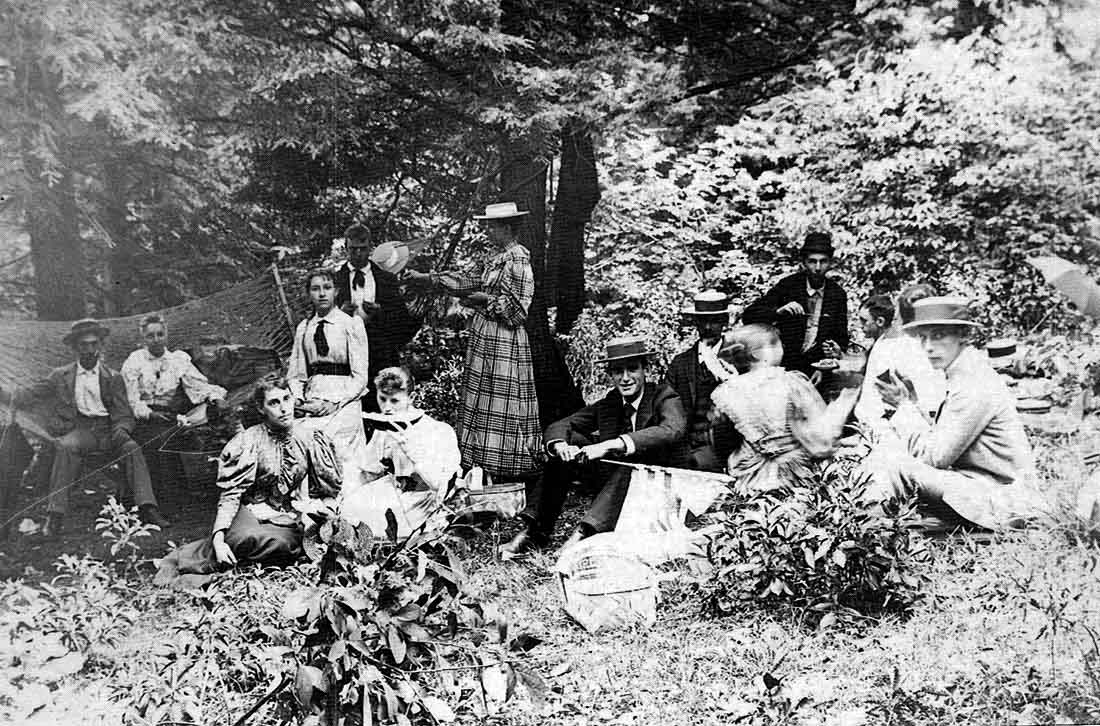 I am sure many Gaylordsville residents do not know why Emanuel Williamson Park got its name.
I am sure many Gaylordsville residents do not know why Emanuel Williamson Park got its name.
Emanuel, or Manuel as he was called, came from Norway to Gaylordsville in the early 1900’s. He came to the Thompson Farm that was located at the intersection of Gaylord Road and Cedar Hill Road and is now mostly covered by houses. Emanuel worked there until the start of WW I when he joined the Army and served overseas.
After the war he came back to the farm for awhile then got a job in the Locomobile factory in Bridgeport, CT. Locomobile was a small company that built expensive cars.
When Route 7 was completed he came back to Gaylordsville, bought an old horse barn and in it opened Gaylordsville’s first garage. He became one of Gaylordsville’s best known citizens and Manuel or the "Square Head", was known for miles on both sides of Gaylordsville. He was referred to as "Square Head" because of his Norwegian heritage. He once got a card mailed in Europe to "The Square Head", Gaylordsville, CT USA, which he enjoyed showing at the garage.
He was one of the leaders in forming the fire department and was well known in New Milford as well as Gaylordsville.
Camping in Gaylordsville
 The campers were five boys between the ages of l0 to 13: Charlie Jones, Lester Leviness, Jim Dolan, Jack Dodd and Alan Dodd.
The campers were five boys between the ages of l0 to 13: Charlie Jones, Lester Leviness, Jim Dolan, Jack Dodd and Alan Dodd.
The camp was in the woods behind what is now Strait's Rock Estates, between the woods and Route 7 was pasture land.
Jack and I had a 7x9 wall tent for sleeping and Charlie had a pup tent for supplies. Jack and I had camped the year before with an older cousin for a couple of days so were not entirely green. After getting everything up the hill to camp (a big job!,) we set up the tents and ditched around them in case of rain....very important! We cut hemlock boughs to make our beds, five in a row, covered with blankets, with a kerosene lantern hung from the ridgepole so we could play games until ready to sleep.
We had pancakes for breakfast. Everyone cooked their own and turned them by flipping and had to eat them no matter where they landed. We learned that if you burnt them a little, they flipped better. Bacon and eggs and fried potatoes were some of our staples. Mother kept us supplied with cold boiled potatoes to fry. Canned beans and spaghetti also were on the menu.
One night some horses knocked down our supply tent. We had to get up and set that up again. There was no damage to the sleeping tent. We spent a lot of time in the nearby river every day. We always took our hikes every day to see if our mothers had any donations. They usually did.
We went in Tories Cave with candles for light and a ball of twine so we could find our way out.
All too soon the week was over…..a happy memory of my childhood. Also, too soon we were old enough to work. Somebody always had to work so we didn't get our week together any more.
